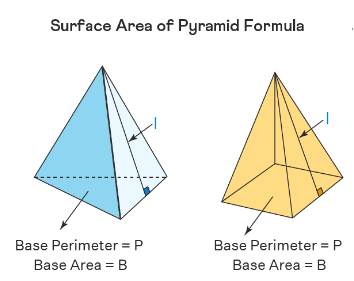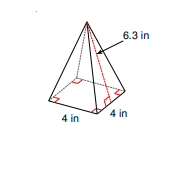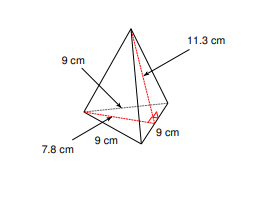How to Find the Surface Area of Pyramid?
The surface area of a pyramid is defined as the sum of the area of all its faces. In this guide, you will learn how to find the surface area of the pyramid.

A pyramid is a three-dimensional shape whose base is polygonal and whose sides (which are triangles) meet at a point called the apex (or) vertex. The perpendicular distance from the vertex to the center of the base is called the altitude or height of the pyramid. The length of the perpendicular drawn from the apex to the base of a triangle (side face) is called the slant height.
Related Topics
A step-by-step guide to finding the surface area of a pyramid
The surface area of a pyramid is the measure of the total area occupied by all its facets.
The surface area of a pyramid is the sum of the area of its faces and hence it is measured in square units. A pyramid has two types of surface areas, one is the Lateral Surface Area \((LSA)\) and the other is the Total Surface Area \((TSA)\).
- The Lateral Surface Area \((LSA)\) of a pyramid \(=\) The sum of areas of the side faces (triangles) of the pyramid.
- The Total Surface Area \((TSA)\) of a pyramid \(= LSA\) of pyramid \(+\) Base area
Note: The surface area of a pyramid without any specifications refers to the total surface area of the pyramid.
The surface area of a pyramid formula
We can calculate the surface area of a pyramid by finding the area of each of its faces and their sum. If the pyramid is regular, there are special formulas for finding the lateral surface area and total surface area.
Consider a regular pyramid with a base perimeter of \(P\), a base area of \(B\), and a slant height of (height of each triangle) \(l\). Then,

- \(\color {blue}{LSA= \frac{1}{2} Pl}\)
- \(\color{blue}{TSA = LSA + base\:area = \frac{1}{2} Pl + B}\)
Note that here we use the polygon area formula to calculate the base area.
Finding the Surface Area of Pyramid – Example 1:
The side length of the base is \(15\) inches and the slant height of the pyramid is \(18\) inches. Calculate the lateral surface area of a square pyramid.
Solution:
The side length of the base, \(a=15\) inches
Then, the perimeter of the base (square) is \(P = 4a = 4(15) = 60\) inches.
Slant height, \(l= 18\) inches
The lateral surface area of a square pyramid is,
\(LSA = \frac{1}{2}Pl\)
\(= \frac{1}{2} × (60) × 18\)
\(= 540\space in^2\)
Exercises for Finding the Surface Area of Pyramid
- Find the lateral area and surface area of each figure. Round your answers to the nearest tenth



- \(\color{blue}{50.4\space in^2, 66.4 \space in^2 }\)
- \(\color{blue}{152.6\space cm^2, 187.7 \space cm^2 }\)
Related to This Article
More math articles
- Word Problems Involving Rates and Ratios
- Pattern Power: How to Unravel Division Trends Across Expanding Place Values
- FTCE Math FREE Sample Practice Questions
- Overview of Upper-Level SSAT Mathematics Test
- How to Ace the GED Math Formulas
- Double Digits, Double Fun: How to Solve Word Problems with Two-digit Divisors
- The Significance of the Unit Circle in Trigonometric Functions
- How to Write Linear Functions Word Problems
- How much does the CBEST Test Cost?
- Cofunction Identities


























What people say about "How to Find the Surface Area of Pyramid? - Effortless Math: We Help Students Learn to LOVE Mathematics"?
No one replied yet.